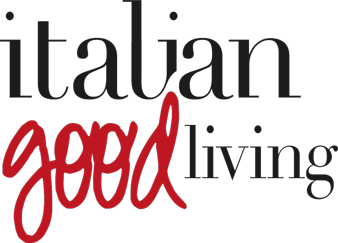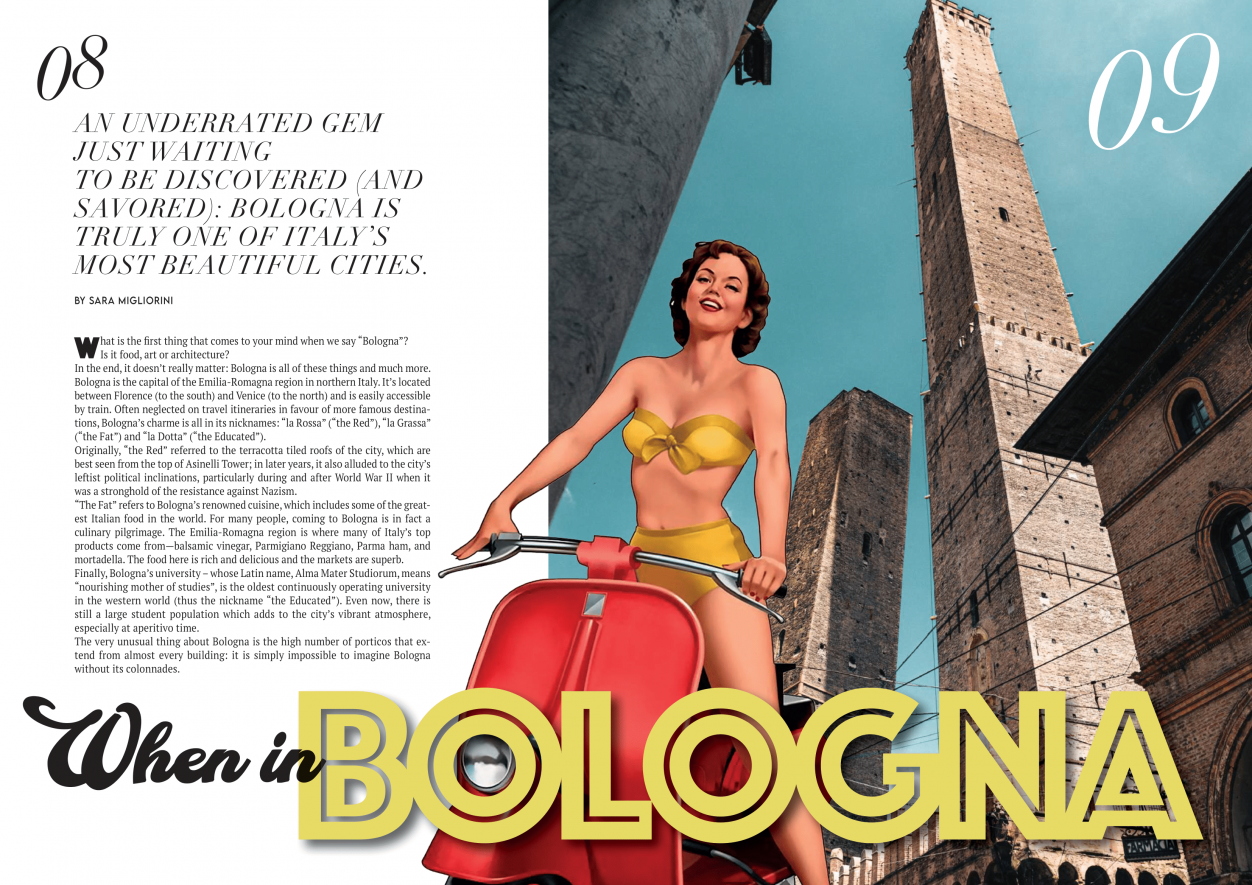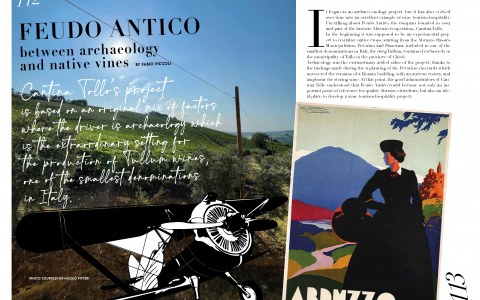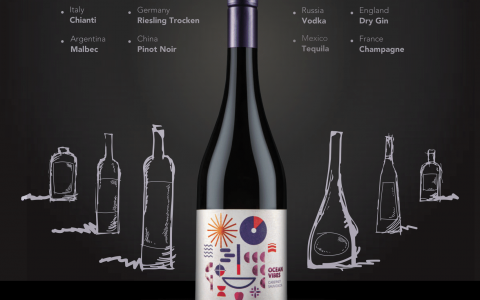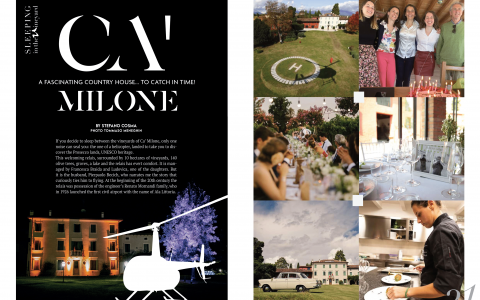When in Bologna…
An underrated gem just waiting to be discovered (and savored): Bologna is truly one of Italy’s most beautiful cities.
by Sara Migliorini
What is the first thing that comes to your mind when we say “Bologna”?
Is it food, art or architecture?
In the end, it doesn’t really matter: Bologna is all of these things and much more.
Bologna is the capital of the Emilia-Romagna region in northern Italy. It’s located between Florence (to the south) and Venice (to the north) and is easily accessible by train. Often neglected on travel itineraries in favour of more famous destinations, Bologna’s charme is all in its nicknames: “la Rossa” (“the Red”), “la Grassa” (“the Fat”) and “la Dotta” (“the Educated”).
Originally, “the Red” referred to the terracotta tiled roofs of the city, which are best seen from the top of Asinelli Tower; in later years, it also alluded to the city’s leftist political inclinations, particularly during and after World War II when it was a stronghold of the resistance against Nazism.
“The Fat” refers to Bologna’s renowned cuisine, which includes some of the greatest Italian food in the world. For many people, coming to Bologna is in fact a culinary pilgrimage. The Emilia-Romagna region is where many of Italy’s top products come from—balsamic vinegar, Parmigiano Reggiano, Parma ham, and mortadella.
The food here is rich and delicious and the markets are superb.
Finally, Bologna’s university – whose Latin name, Alma Mater Studiorum, means “nourishing mother of studies”, is the oldest continuously operating university in the western world (thus the nickname “the Educated”). Even now, there is still a large student population which adds to the city’s vibrant atmosphere, especially at aperitivo time.
The very unusual thing about Bologna is the high number of porticoes that extend from almost every building: it is simply impossible to imagine Bologna without its colonnades.
An architectural feature widespread throughout the city, the colonnade has become a symbol of the city itself, like its famous two towers (“Torre degli Asinelli” and “Garisenda”) or bolognese sauce. There is no other city in the world with more porticoes than Bologna: all together, and only taking into consideration the city centre, they are more than 42 km long. Bologna is also home to the world’s longest portico, which stretches approximately 4 kilometers from just outside the city walls to the Santuario di Madonna di San Luca.
The porticoes are such an integral part of the city’s urban fabric that the UNESCO committee officially designated Bologna the “City of Porticoes” with its nomination as World Heritage Site. The porticoes, like a living artwork, paint the streets with lights, shadows, and fascinating architectural views (ideal for street photography!).
Halfway between “inside” and “outside”, these attractive arches were originally built from wood in the late Middle Ages to provide extra living space. The colonnades have long encouraged social interaction and craft activities, but they also serve a functional purpose by providing shelter from the weather and the sun, allowing Bolognese residents and tourists alike to walk about the city with a roof over their heads. They are the umbrella under which one can take cover when it rains, but also the ideal spot to cool down on hot summer days.
As a result, the porticoes are social gathering spots and shopping alleys, including clubs, museums, and art galleries.
As strange as it may sound, these astonishing architectural wonders sprang from illicit building activities throughout the Middle Ages. Built without strict planning laws and at different times, it is impossible to find two porticos in Bologna that are identical to each other.
Things to Do in Bologna:
- Stop by Piazza Maggiore and grab a coffee
Bologna’s main square is a must-see on any visit to the city and the perfect first stop on any trip to Bologna. The huge piazzais a public place surrounded on all sides by centuries-old medieval structures, including the principal church, Basilica di San Petronio, and City Hall.
On the northeast corner, the Piazza Maggiore holds the elaborate Neptune Fountain, one of the symbols of the city, and the Biblioteca Salaborsa, the Public Library.
Grab a coffee, cappuccino, or spritz from one of the shaded cafés and relax while watching the city go by: this location offers some of the greatest people-watching opportunities in the city.
- Climb the Asinelli Tower
The leaning towers of Asinelli and Garisenda are immediately next to one other, and if you’re prepared for a long climb (all 498 steps), Asinelli is open for tours and offers stunning views of Bologna.
- Visit San Petronio’s Terrace for great views of Bologna
Though the Asinelli Tower boasts the best view in Bologna, San Petronio’s Terrace is one of the most popular spots. People tend to prefer the views of a city’s most iconic monuments, and San Petronio’s Terrace has a fantastic view of Bologna’s leaning towers!
- Find Bologna’s hidden canals
Bologna is home to multiple canals that date back to the Middle Ages, but finding them is a bit of a treasure hunt. As the city has expanded, several of the canals have been walled up or may only be viewed from specific locations (one can only be seen through a window!). If you wander along Via Piella, for example, (where you’ll also find several great restaurants), you’ll see a small window built into the wall, through which you can spot the canals.
The city provides tourists and residents with a good map of the canals, and the stroll through town is a great chance to see more of Bologna along the way.
- Explore Bologna’s Museum of Modern Art (MAMbo)
If you’re tired of walking to see all of Bologna’s ancient monuments, why not spending an afternoon checking out something a little more modern?
Located in a former bread bakery, Bologna’s Museum of Modern Art (MAMbo) is now a center for creation and experimentation, with permanent and borrowed collections spread across 9,500sqm of contemporary, architecturally flowing floorspace.
- Take a Bologna Food Tour
The cuisine is one of the main reasons to visit Bologna, and it’s well worth taking a food tour One of the primary reasons to visit Bologna is the cuisine, and it’s definitely worth taking a food tour at the start of your stay to discover more about the culinary culture.
The tour usually starts at the city’s best coffee shop and continues around the markets and food shops, sampling olive oil and aged balsamic vinegar (and experiencing what true balsamic tastes like) and learning about the greatest local goods.
- Go Food Shopping in the Quadrilatero or in Mercato Delle Erbe
Just steps from the Piazza Maggiore is the Quadrilatero, one of the most atmospheric areas of the city and the oldest market in Bologna. Since the Middle Ages, this cluster of little lanes off the main square has served as Bologna’s market, and it is still bustling with delis and shops offering massive wheels of parmesan, Parma ham, and beautiful stacks of fruit and vegetables.
For fresh produce, we recommend Mercato Delle Erbe, where fruit and vegetables come from every part of Italy. There’s also an upscale food court where you may have local snacks like sandwiches and piadina, or even a full dinner.
- Enjoy an Aperitivo
The Mercato delle Erbe and the bars across the street are a good place for aperitivo in Bologna. “Aperitivo”—a pre-dinner drink with snacks—is a prominent tradition here: just explore the streets after 6 p.m. and you’ll discover a profusion of bars serving anything from peanuts and crisps to meal-sized buffets.
The most popular happy hour cocktail is “Aperol Spritz”, made with Aperol, Prosecco, and soda water (plus, occasionally, Campari) and usually served with a piece of orange in a big wine class.
